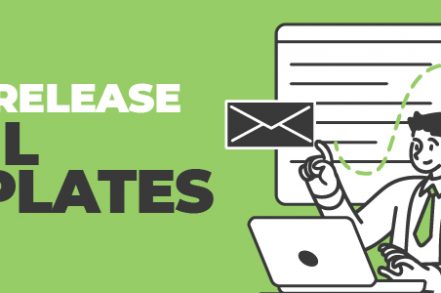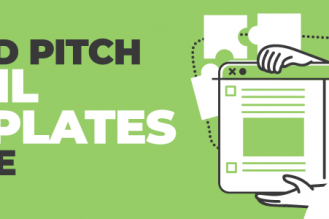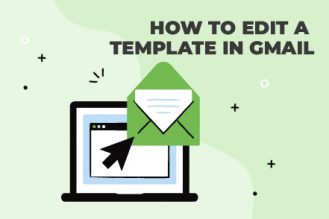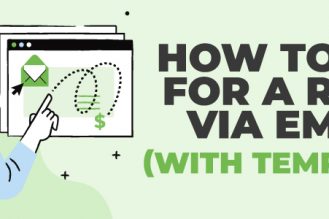When it comes to spreading awareness of your brand, press releases are your friend and press release email templates are your best friend. They are the easiest and most effective way to put your brand and yourself on journalists’ radars and achieve press coverage.
Brands traditionally put out press releases to their media contacts for product launches and upcoming events. They’re also commonly used as the first line of defence for PR crises – to get your side of the story across to the press quickly and effectively, and thereby achieve some level of damage control.
The question here is: how can you structure your press release to really capture a journalist’s attention? What information do they need, and how long should your press release be?
Given how useful press releases can be in a variety of situations, we’ve put together 6 easy-to-use templates for different situations.
1. Product Launch
Hi [name],
- Headline: This should grab attention and excite people about your product. This will also be your subject line.
- Embargo, if relevant: This tells journalists and publications when they’re permitted to announce the news of your new product launch
- Lead: The main point of your press release – for example, what exciting features does your product have, why is it better than other similar products on the market?
- Body: More information about the product and the brand. Bullet points often work well for the body of a press release
- Quote: A quote from your CEO, happy customers, or a relevant expert about the new product for journalists to include in their story
- Contact information: The company’s contact information for journalists
Many thanks,
[Name]
2. Event
Hi [name],
- Headline: [Company/Individual] is delighted to present [the 1st/2nd/10th][event name].
- Big names: Be sure to include the names of any notable speakers or entertainment high up in the body copy. Why should people attend the event? Answer this first.
- Details: Date, location, and itinerary of event
- More details: Ticket and contact information
- Quote: Use quote from performer/person being honored/previous attendee/CEO
- Company information: Boilerplate information about the company hosting the event and the history of the event
Many thanks,
[Name]
3. Research
Hi [name],
- Headline: Lead stat from research
- Information about study: Brief outline of who conducted the study and the sample size
- Other key stats: Include approximately five more key stats from the research
- Context: Why was the study conducted? What makes it relevant to your audience?
- Quotes: Include quotes from authors of study, and the company who conducted the research
- Contact details: Include contact details for journalists who want to find out more about the study or interview a relevant party
- Company information: Boilerplate information about the company that carried out the research
Many thanks,
[Name]
4. Crisis Management
Hi [name],
- Context: For example, “as you may have seen, there have been news reports circulating this morning about [crisis] at [brand].”
- Explanation: Where appropriate, explain why this crisis has occurred
- Actions taken: What actions you have taken in response to the crisis
- Why: Why has this been your choice of response?
- Future: What are the next steps, and what can your customers expect going forward?
- Quote: Quote from CEO or individual leading the response to the crisis in question
- Sign off: Apology (where appropriate), a promise to keep your customers updated, and a thank you for their patience/understanding.
Many thanks,
[Name]
5. Content Outreach
Hi [name],
- Headline: Lead from content – e.g. [brand] launches exclusive infographic showing [subject]
- Key points: Key points from the content – this could be stats from exclusive research, opinions from relevant people, or the key points made within the content
- Link: Link to the content where appropriate, or – if the content is visual– include it in the body of the email or tell the reader it is attached.
- Information about content: Who put the content together and why?
- Sell it: Who do you think will be interested in the content? Why will it be of interest to the journalist/publication’s audience?
- Quotes: Include quotes from relevant parties
- Conditions of using content: If you’re asking for a link back to your social media channels or website, make sure to include this in your email
- Contact details: Include contact details for journalists who want to find out more about the content, or are interested in collaborating with you
- Company information: Boilerplate information about the company that put the content together
Many thanks,
[Name]
6. Offering Quotes
Hi [name],
- Context for email: For example, “I’ve seen [x event] in the news this morning.” Include a link to the news story here.
- Sell yourself: Who are you, and why do you have a unique and important perspective on [x event]? What qualifies you to comment on it? Consider linking to your website or LinkedIn here to back up your claims
- Quote: Include a standard quote you would be happy to have published within your email – this makes it super easy for time-poor journalists to include your quote in their article
- Attribution instructions: How would you like to be referred to in the article? E.g. [name], [job title], [age].
- Offer an interview: Make it clear you are open for an interview should the journalist wish to feature more of your perspective in the article, or even base the article around your perspective.
- Contact details: Your contact details in case they want to interview you or need more information on your perspective.
- Company information: Boilerplate information about the company you’re representing
Many thanks,
[Name]
7. Collaboration
Hi [name],
- Headline: This should summarize the collaboration efforts
- Primary Parties: What are the two (or more) parties
- Lead: What is the most interesting part of this collaboration?
- Body: Expand on both parties, what value they bring, and what their philosophies are.
- Quote: Provide a quote from the CEO, or an important figure, from either party to solidify the article.
- Contact information: Provide a way for journalists to get in touch.
Many thanks,
[Name]
8. New Division
Hi [name],
- Headline: Boil down the idea of the press release into one sentence
- Company and division: Mention the company and the new division it’s starting
- Lead: What will this new division do that is significant? Will it solve an existing market need?
- Body: Expand on the division. Mention who will be involved, research and development, and other important factors
- Quote: Quote someone who is leading the efforts on the new division
- Contact information: Let journalists know how to reach the company for feedback
Many thanks,
[Name]
9. Acquisition
Hi [name],
- Headline: What’s the gist of the press release?
- Primary Parties: Who are the two companies, and who’s acquiring who?
- Lead: This should be the crux of the press release. Provide the most relevant information right up front
- Body: Expand on each company. What is their background, and why are they merging in the first place?
- Quote: Get some short quotes from the C-suite in each company to provide some authority in the press release
- Contact information: Make sure that you get maximum publicity by providing a method of contact
Many thanks,
[Name]
10. Charity
Hi [name],
- Headline: What is the nature of this press release?
- Charity and company: Mention the company and the charitable cause they are supporting
- Lead: What stands out about this charitable event?
- Body: Get into the details of the philosophy of the company and why they chose to donate to their selected charity in the first place
- Quote: Get someone from the company and the charity on record giving their view on the matter
- Contact information: Provide emails or phone numbers so journalists can get in touch
Many thanks,
[Name]
For press releases to be effective, they need to go out to as many journalists, prospects, and publications as possible. That’s where press release email templates come in.
Sending these emails one by one is a tedious and time consuming task, when your time could be better spent elsewhere.
By using Right Inbox gmail follow up and gmail templates tools, you can make communicating and building relationships with media professionals easier and more effective than ever.
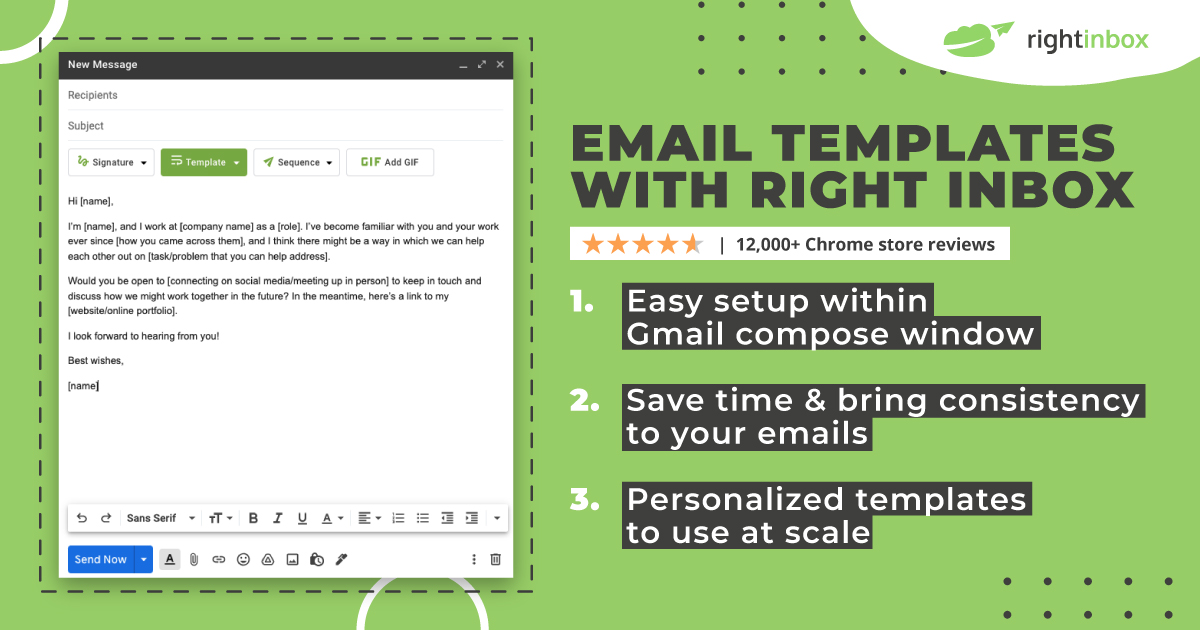
Have you started using Right Inbox’s email templates for sending press releases?
Track emails, email reminders & templates in Gmail for free
Upgrade Gmail with the features it’s missing
Add to GmailDavid Campbell
David Campbell is the editor of the Right Inbox blog. He is passionate about email productivity and getting more done in less time.
